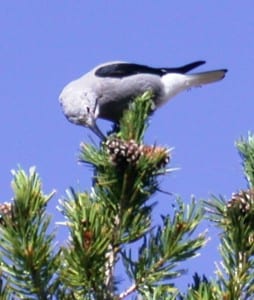Clark’s nutcrackers carry seeds from whitebark pine trees much farther than previously known, according to the newly published results of a research study funded in part by Seattle City Light.
The study conducted by Teresa Lorenz in the Cascade Mountains of Washington found that the large pale gray birds with black and white wings and tails carried seeds up to 33 kilometers, or about 20 miles, to store them for eating later. Previously, the maximum distance recorded for transporting a whitebark pine seed was 12.5 kilometers and the longest distance for any pine seed was 22 kilometers.
“Nutcrackers play an indispensable role in the lifecycle for whitebark pine,” Lorenz said. “Without the seed storage behavior of nutcrackers, germination by the tree would be limited at best, possibly not even occur in many areas.”
Whitebark pine forests are an important food source for many animals, including red squirrels, grizzly bears and black bears. Old whitebark pines provide valuable spaces for nesting squirrels, northern flickers and mountain bluebirds.
The trees have other important roles in the environment. Because they can grow in dry, windy and cold area where no other trees can get started, whitebark pine is a pioneer tree in many harsh subalpine and alpine environments. Once whitebark pines are established, they can change the climate in the immediate area enough that other trees can start to grow.
Additionally, the trees’ broad crowns tend to act as snow fences along windy ridges, helping snow accumulate at high elevations. This delays some of the snow melt, extending stream flows into the summer months.
Biologists are concerned about the future of those forests because of the whitebark pine’s vulnerability to white pine blister rust, mountain pine beetle infestation, wildfires and climate change.
Whitebark pine cones don’t open on their own the way most pine cones do. Instead, their seeds are spread when Clark’s nutcrackers use their chisel-like bills to break open the pine cones and carry off the seeds.
Clark’s nutcrackers, members of the crow family, are well-built for the task. In addition to their long, pointed bills, the 12.5-inch-long birds also have pouches beneath their tongues that can carry about 80 seeds at a time.
The bird is named after William Clark of the Lewis and Clark expedition and was first observed by the Corps of Discovery in 1805.
While Lorenz found that the nutcrackers carry seeds great distances, the birds often hide them in trees or other locations that are unlikely to allow the seeds to germinate. Each tree, however, can produce hundreds of thousands of seeds in a good year and needs only one of those seeds to grow into a mature tree to maintain the population.
“We were able to obtain new information on habitats important for the conservation of nutcrackers,” Lorenz said.
Findings from the study, including seed zone boundaries, were directly incorporated into the Pacific Northwest Whitebark Pine Restoration Strategy (http://www.fs.fed.us/r6/genetics/programs/whitebark-pine/).
Lorenz spent four years tracking 54 adult nutcrackers at 10 sites in the Cascade and Olympic Mountains. The birds were fitted with a backpack-style harness with radio tags that could be monitored on foot and by aircraft. Her team obtained more than 6,000 tracking point locations on the birds. They observed more than 1,000 seed harvest events and 655 seed-caching events.
Seattle City Light supports wildlife and fish research as a part of its commitment to generate electricity for its customers in an environmentally responsible manner. Wildlife research grants are required by the Federal Energy Regulatory Commission license to operate the Skagit Hydroelectric Project. A committee of biologists from wildlife and land management agencies and university faculty decide which projects receive funding to promote wildlife management in the North Cascades.
“Results from this study show the importance of the Clark’s nutcracker as a seed disperser in whitebark pine areas and will help agencies participating in the Skagit Wildlife Management Review Committee make decisions about habitat management,” City Light Biologist Ron Tressler said.
Others that provided funding for the research were the U.S. Forest Service; Utah State University Biology Department; and Utah State University Ecology Center.
“Without sources of funding like the Seattle City Light program, we would not have been able to conduct our research study,” Lorenz said. “The funding was key to the success and even the existence of our project.
Seattle City Light is the 10th largest public electric utility in the United States. It has some of the lowest cost customer rates of any urban utility, providing reliable, renewable power to nearly 1 million Seattle area residents. City Light has been greenhouse gas neutral since 2005, the first electric utility in the nation to achieve that distinction.
Fact sheets from Lorenz’s study are available at http://ecoshare.info/projects/whitebark-pine/ .

